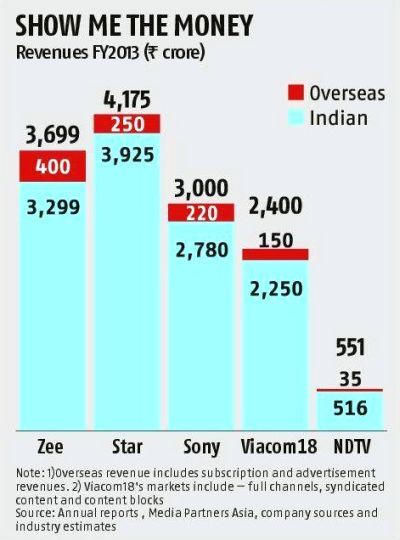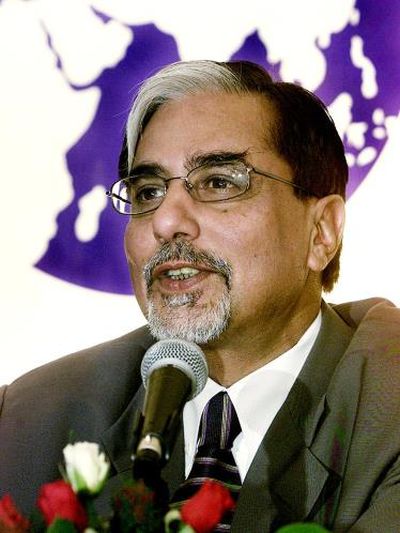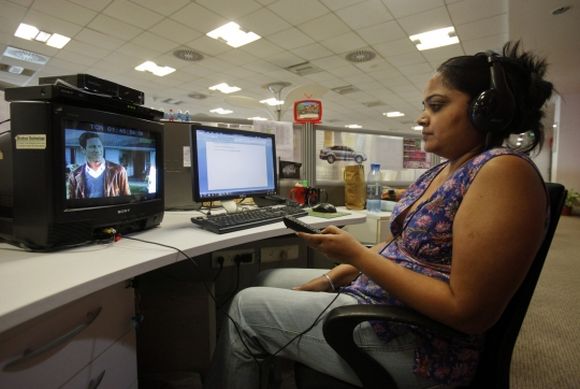Photographs: Courtesy, Sony Vanita Kohli-Khandekar in New Delhi
In July, Zee Entertainment, one of India's largest broadcasters, adopted a new philosophy and tagline: Vasudhaiva Kutumbakam, the world is one family.
It comes after the company made a strategic shift last year when it set its aim to become a global broadcaster reaching out to a billion viewers by 2020 from 700 million now. By then, it also hopes to get over a third of its revenues from markets outside India.
"We have achieved 65 per cent penetration with the South Asian diaspora, but the second and fourth generations are not as connected to India," says Punit Goenka, managing director and CEO, Zee Entertainment.
A combination of factors - young audiences who are not interested in Indian content, powerful cable and satellite operators who make distribution difficult and competition from other Indian channels - has forced broadcasters to relook at the Rs 1,500-crore (Rs 15 billion) overseas market for Indian TV content in the last five years.
Zee, Viacom18, Star and Sony are using everything they can - syndication deals, distribution through cable, DTH (direct-to-home) and OTT (over-the-top) operators that distribute TV via the internet, launching full-fledged local channels and even setting up local production companies - in their bid to woo newer audiences around the world.
…
Indian TV channels go on war overseas
"There is a huge demand for Indian content in many markets in East Europe and Asia, and it is a high-margin business," says Vivek Couto, executive director, Media Partners Asia, a Hong Kong-based consulting firm. Gaurav Gandhi, chief operating officer, Indiacast, Viacom18 and TV18's distribution arm, believes that there are three basic approaches to the global market.
One is the diaspora markets in the United States, United Kingdom and West Asia where the bulk of the 30 million non-resident Indians live.
Zee is the oldest player in this game. When it set up shop outside India over 15 years ago, all a broadcaster needed was a deal with the local cable or satellite operator and it was on air.
Over the years, as transponder costs fell, almost everyone jumped in. For instance, there are 40 Indian channels in the UK and about 90 in the US and Canada. This has led to undercutting.
"From $5, the net realisation (the final amount received) of Indian channels has gone down to $2 and even lower for some of the newer ones," says Rahul Sood, head of affiliate sales and distribution, NDTV.
…
Indian TV channels go on war overseas
Photographs: Courtesy Zee TV
In the UK and West Asia, hyper-competition has meant that the ratio between subscription and advertising revenues in many markets has moved from 80:20 to 30:70.
So, incumbents such as Zee are consolidating heavily, launching more local channels and going free-to-air to get more advertising revenues.
"The free-to-air strategy works only in the UK and West Asia because these are controlled by a few distributors. In markets where there are many distributors (like the US), it is still the pay strategy that works," says Goenka.
The other way of dealing with falling viewers in mature markets is dubbing, subtitling and overhauling content for young Indians.
"All four (Star Jalsha, Star Plus, Star Gold and Life OK) of our channels have English subtitles and it has worked to get the younger audiences (in the UK)," says Rajan Singh, executive vice-president (international business), Star India.
The second approach to global growth is through markets where it is difficult to launch a full-fledged channel or where the market is not big enough; for example, Pakistan or Azerbaijan.
…
Indian TV channels go on war overseas
Image: A still from TV serial Balika Vadhu.Photographs: Courtesy Colours
Viacom18 is finding its sweet spot through syndication in many such markets. In addition to the 80 countries where it has channels, Viacom18 syndicates its content in dubbed or sub-titled form to local channels in 125 countries in Dari, Pashto, and Japanese, among other languages.
So Balika Vadhu, for instance, is available in 15 languages. This could get $500-$2,000 per episode, depending on the country, time of telecast et cetera.
Viacom18 gets roughly three-fourths of its syndication revenues from East Europe, Africa and other non-traditional markets.
"For me, the big change and opportunity is not about focusing on NRIs, but on locals in markets that are closer to India in developmental terms," says Gandhi.
The third way of reaching out to new audiences is by remaking the shows for some of the fast-growing or profitable markets or even going completely local in such markets.
Colors' Uttaran, already dubbed and subtitled in 15 languages, is now being remade in Swahili. MTV's Roadies is being remade for Bangladesh.
…
Indian TV channels go on war overseas
Image: Zee Chairman Subhash Chandra.Photographs: Reuters
Goenka agrees but points to the one big issue with Indian programming - its length. Zee Alwan, an Arabic general entertainment channel launched in the United Arab Emirates last year, involved lots of re-editing and repackaging of soaps into shorter episodes.
He says that a huge creative rethink is needed if an Indian broadcaster wants to truly go global.
Thus, Veria Living, a channel from a sister company of Zee, caters to the American audience with programming that is created out of a studio in New York.
Zee Chairman Subhash Chandra, who is running the Veria business, believes it is a critical first step in Zee's ambition to become a global media firm.
Broadcasters are also looking at OTT operators such as FETCH TV, YuppTV or Your TV, among others, to expand their global audience base.
OTTs are TV distributors just like DTH or cable operators, but they have alignments with major broadband/internet service providers.
…
Indian TV channels go on war overseas
Image: An in-house censor reviews a movie which will eventually air on the Sony Pix.Photographs: Vivek Prakash/Reuters
YuppTV, for instance, offers legally licensed programming from 150 Indian channels on any device - TV, PCs, smartphones or laptops - to Asian viewers in the US, Europe and Australia.
The push for advertising revenues in global markets also brings pressure on broadcasters to "effectively measure consumer interest in content," says Harsha Aggarwal, director, VisionAsia, the dominant South Asian pay-TV provider in Australia and New Zealand.
Most Indian broadcasters have started subscribing to BARB (Broadcasters Audience Research Board data) in the UK or are part of the Ipsos rating system in the UAE.
However, in the US, things are not so simple because Nielsen does not include channels without a certain national reach in its surveys.
So, except for Zee, no other Indian channel features on the Nielsen ratings. Indian broadcasters may be willing to be a part of the global family, but it will be a long time before the rest of the world accepts them into their living rooms.








article